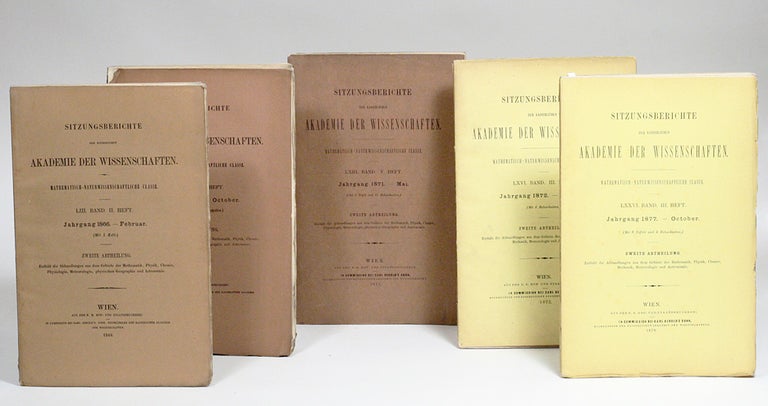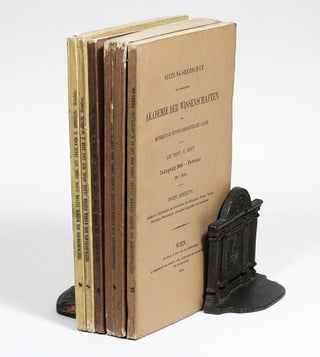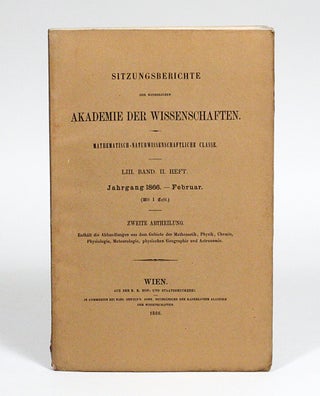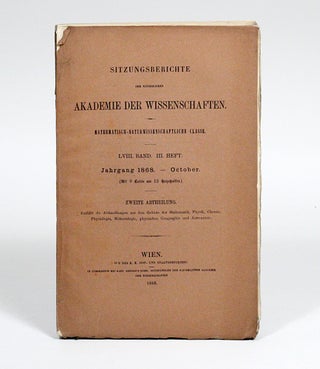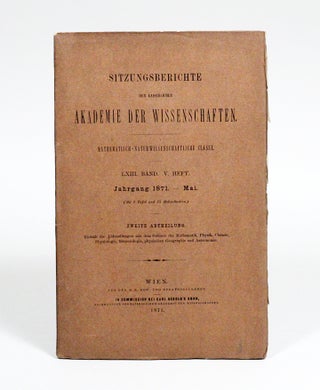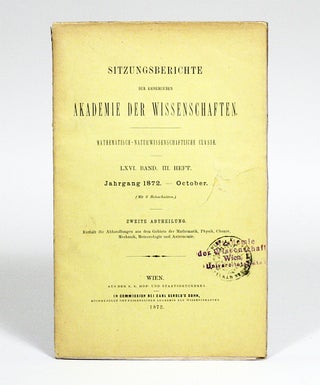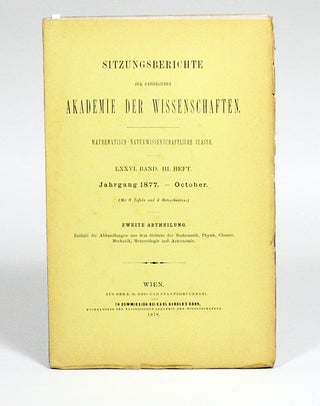Über die mechanische Bedeutung des zweiten Hauptsatzes der Wärmetheorie (1866). WITH: Studien über das Gleichgewicht der lebendigen Kraft zwischen bewegten materiellen Punkten (1868). WITH: Einige allgemeine Sätze über Wärmegleichgewicht (1871). WITH: Weitere Studien über das Warmegleichgewicht unter Gasmoleculen (1872). WITH: Über die Beziehung zwischen dem zweiten hauptsatze der mechanischen Warmetheorie und der Wahrscheinlichkeitsrechnung... (1877)
“Zentralfriedhof, Vienna’s largest and most famous cemetery, is the final resting place for many important Europeans. The cemetery has a particularly notable constituency of composers: Beethoven, Brahms, Schoenberg, Schubert, and the Strauss family are all buried there. Perhaps the most intriguing grave site, however, belongs to Ludwig Boltzmann, the Austrian physicist known for his contributions to statistical mechanics and thermodynamics. While his tombstone is surely not the grandest, it is interesting for its simple and unique inscription: S = k log W.” –“Boltzmann’s Grave” in Atlas Obscura
“It was late afternoon, approaching early evening, on September 5 of [1906]. [Ludwig Boltzmann] had traveled to the coastal village of Duino with his wife and three daughters. … Boltzmann had already lived more days than he could bear. And although he had planned to return to Vienna the following day, he decided that he would rather kill himself …. So as his family went down to the sea to bathe, Boltzmann set about the task of committing suicide. … Boltzmann was a man of reason who suffered, often for no good reason and of his own doing. … Yet he managed to create great things. And chief among his many accomplishments is the equation that is inscribed atop his monument: S = k log W. If we are to understand Boltzmann, we need to understand this equation.” –Eric Johnson, “Anxiety and the Equation: Understanding Boltzmann’s Entropy”
THE ORIGIN OF STATISTICAL MECHANICS: FIRST EDITIONS, JOURNAL ISSUES, IN ORIGINAL WRAPPERS, OF LUDWIG BOLTZMANN’S ATTEMPTS TO DERIVE THE SECOND LAW OF THERMODYNAMICS FROM THE BASIC PRINCIPLES OF MOLECULAR MECHANICS, AND HIS PROPOSAL OF THE “ERGODIC HYPOTHESIS.”.
Overview:
The Second Law of Thermodynamics, in one of its many equivalent forms, states that certain physical processes — such as the expansion of a gas as it fills a container, or the mixing of two initially separated gases — proceed spontaneously in only one direction, so that, for example, we never observe two uniformly mixed and non-interacting gases spontaneously accumulate in separate ends of their container. An egg does not spontaneously unscramble; scattered pool balls do not spontaneously re-assemble into a perfect triangle. The fact that such processes proceed spontaneously in only one direction can be described in terms of a thermodynamic variable known as entropy (introduced by Rudolf Clausius in 1865), which increases as a system evolves through time, ultimately reaching a maximum when the system attains an equilibrium state, in which it thereafter remains.
The status of the Second Law has long been a matter of debate. Is it an independent law of nature, which simply has to be accepted as such without further justification, or can it somehow be derived from other, more fundamental principles? Finding such a derivation was the task that the great — and greatly troubled — nineteenth-century physicist Ludwig Boltzmann set for himself, and achieved to varying degrees in the five papers offered here. In particular, since there was an emerging scientific consensus in Boltzmann’s day that matter was made up of particles called “molecules,” Boltzmann sought to derive the Second Law from the application of the basic principles of mechanics, such as Newton’s three laws of motion and their corollaries, to systems of large numbers of molecules — imagined as being something like pool balls, traveling through empty space and occasionally colliding with one another or with the walls of their container.
In a sense, the project was doomed from the start, since the fundamental laws of classical mechanics are symmetrical in time. For example, a movie showing a rack of pool balls being struck by a cue ball and scattering over a pool table would be equally consistent with the laws of Newtonian mechanics whether the film were run forwards or backwards. How, then, can such time-symmetric mechanical laws be reconciled with the manifestly time-asymmetric Second Law?
Although Boltzmann appeared to have derived the Second Law in a brilliant 1872 tour-de-force, included among the papers offered here, he later realized, prompted by cogent criticisms from other scientists, that his derivation implicitly incorporated an unsupported assumption that was itself asymmetric in time. Upon realizing this, he went back to the drawing board, and in an 1877 paper (also offered here) re-derived the Second Law from probabilistic considerations — in other words, reframing it as a statement not of mechanical necessity, but of the most likely path for a system to follow. The insights presented by Boltzmann in his 1877 paper continue to be central to the modern understanding of the statistical behavior of molecules, as developed by Gibbs and others, whether those molecules are governed by the laws of classical mechanical or by those of quantum mechanics.
Brilliant and important as Boltzmann’s 1877 paper was, like all theoretical innovations it left loose ends, disturbing conceptual issues that continue to trouble the sleep of physicists and philosophers. One of these is whether natural systems have a property known as “ergodicity.” In one of its many essentially equivalent forms, the ergodic theorem holds that the time average of the states of a system as it evolves in accordance with the laws of mechanics is equal to the weighted average of all possible states, with weights based on the relative likelihood of each state.
Boltzmann first proposed the ergodic assumption in his papers of 1868 and 1871 — not the least of his accomplishments presented in the papers offered here — and the assumption of ergodicity played an important role — sometimes explicit, sometimes implicit — in his subsequent attempts to prove the Second Law. Yet even now the assumption of ergodicity remains controversial. Mathematical physicists have proven that certain models of natural systems are ergodic and certain others are not; and the existence of ergodicity as a characteristic of “typical” and “realistic” physical systems, and its sufficiency and necessity as an underpinning for the Second Law, remain in dispute.
Although Boltzmann did not finally and conclusively resolve the problem of the origins of the Second Law, his analyses laid the groundwork for all of the subsequent work in that area. If Boltzmann did not solve the problem he set himself, it was only because the problem is an intractable one, and a final solution has resisted the best efforts of physicists and philosophers in the century since Boltzmann died.
The 1866, 1868, and 1871 Papers:
Boltzmann’s 1866 paper boldly announced the nature of the project he was undertaking. “The identity of the first principle of the mechanical theory of heat [i.e., the First Law of Thermodynamics] and the principle of live forces [kinetic energy] has long been known; in contrast, the second principle [i.e., the Second Law] has a peculiar exceptional status [eine eigenthümliche exceptionnelle Stellung] and its proof rests on uncertain and never evident detours. The aim of this article is to provide a purely analytical, completely general proof of the second principle of the mechanical theory of heat and also to exhibit the corresponding theorem of mechanics.” (Translation from Olivier Darrigol, “Atoms, Mechanics, and Probability: Ludwig Boltzmann’s Statistico-Mechanical Writings — an Exegesis” (Oxford Univ. Pr. 2018), at 70.) “Boltzmann’s memoir of 1866 is a first expression of his endeavor to reduce thermodynamics to mechanics within a molecular framework. … by a mixture of mechanical reasoning and physical intuition, Boltzmann … obtained an expression of the entropy of a body in terms of purely mechanical variables …. Even though to us some of this reasoning may seem loose or too dependent on unwarranted intuitions, Boltzmann did not hesitate to announce a successful reduction of the second law to a mechanical principle.” (Id. at 78-79.)
In his subsequent papers of 1868 and 1871, Boltzmann sought to build on the work of James Clerk Maxwell, who in 1860 (and in a refined version in 1867) had analyzed the distribution of the velocities of the molecules of a gas at equilibrium. Aside from deriving the distribution, Maxwell proved that it was “stationary” — in other words, that once the equilibrium distribution had been achieved, it would persist. By itself, this was an important step in the direction of Second Law, since it helped explain the peculiar nature of the equilibrium state, if not the details of a system’s approach to equilibrium. In his papers of 1868 and 1871, Boltzmann utilized various approaches to replicate and generalize Maxwell’s results, and also to demonstrate — as Maxwell had not — that the equilibrium distribution was the unique stationary distribution consistent with the laws of mechanics. Both papers utilized versions of the ergodic hypothesis. The molecular-velocity distribution that had been discovered by Maxwell and generalized by Boltzmann is known today as the Maxwell-Boltzmann distribution.
“… Boltzmann must have felt unsatisfied with his own argument [in the 1868 paper]. According to an editorial footnote in his collected works …, Boltzmann’s personal copy of this paper contains a hand-written remark in the margin stating that the point [i.e., the ergodic hypothesis] was still dubious and that it had not been proven ….” (Jos Uffink, “Compendium of the Foundations of Classical Statistical Physics”, in Jeremy Butterfield & John Earman, “Philosophy of Physics” (2007)).. “It seems that Boltzmann regarded the ergodic hypothesis as a special dynamical assumption that may or may not be true, depending upon the nature of the system, and perhaps also on its initial state and the disturbances from its environment. Its role was simply to help derive a result of great generality: for any system for which the hypothesis is true, the equilibrium state is characterized by [an equation essentially equivalent to the Maxwell distribution], regardless of any details of the inter-particle interactions, or indeed whether the system represented is a gas, fluid, solid or any other thermal body.” (Id. at 42.)
The 1872 Paper:
Although the1868 and 1871 papers demonstrate the unique stationary nature of the equilibrium state, they do not show that a system in a non-equilibrium (lower-entropy) state will move spontaneously towards the maximal-entropy equilibrium state. Boltzmann now undertook that next logical step. “Having re-derived the Maxwell-Boltzmann distribution, which describes the distribution of velocities in a sample of gas at equilibrium, Boltzmann was interested in understanding the approach of a sample of a pure monatomic gas to equilibrium from a non-equilibrium state, and this work led to one of his most celebrated papers, which appeared in 1872.” (Jeremy R.H. Tame, “Approaches to Entropy” (2019), at 40.)
Boltzmann’s 1872 paper approached this problem by proving what is now known as the “H theorem.” The theorem asserts that a certain function of the velocities of the molecules in a gas, the “H function,” decreases as the gas moves towards equilibrium. (In fact, Boltzmann used the symbol “E” to describe this function, “but an Englishman called Burbury mistook the German script [E] for ‘H’, and the new usage stuck.” Tame, op cit., at 42.) “Boltzmann believed he had shown that H must decrease with time, unless [the velocity distribution] is a Maxwellian distribution in which case H no longer changes with time. Thus, H plays the role of an entropy function, although because of the sign change H tends to decrease with time, not increase. Since the derivation of the H theorem is based entirely on mechanical reasoning, Boltzmann argued that the entropy must naturally arise from the system of atoms behaving as expected from Newton’s laws.” (Id.).
There was, however, a flaw in Boltzmann’s analysis. “In order to know how the energy distribution will change with time, we need to know how many molecules of one velocity will meet how many molecules of some other specified velocity (and at what angles) in any unit of time. The fundamental assumption Boltzmann makes here is the famous Stosszahlansatz, or Postulate with Regard to Numbers of Collisions. One assumes the absence of any ‘correlation’ among molecules of given velocities, or, in other words, that collisions will be ‘totally random.’ At any time, then, the number of collisions of molecules of velocity v1 and v2 that meet will depend only on the proportion of molecules in the gas that have the respective velocities, the density of the gas, and the proportion of volume swept out by one of the molecules.” (Lawrence Sklar, “Physics and Chance: Philosophical Issues in the Foundations of Statistical Mechanics” (1993), at 32-33.) As later analyses demonstrated, Boltzmann’s version of the Stosszahlansatz had hidden within it an asymmetry with respect to time that was necessary to establish the similar asymmetry of the H function with time. In other words, the fact that the H function decreased with time was not based wholly on the (time-symmetric) laws of molecular mechanics. Boltzmann had, in effect, assumed his conclusion. This became clear in an 1876 paper in which the physicist Josef Loschmidt pointed out that Boltzmann’s conclusion could not be correct because if one takes a system at equilibrium, and “suddenly assumes that the velocities of all atoms are reversed,” “gradually the stationary state would deteriorate, and after passage of time … we would inevitabl[y] return to our initial state ….” (Translation of Loschmidt’s paper from Uffink, op cit.) “The modern reader typically wonders why Boltzmann does not say a word [in his 1872 paper] on the conflict between the reversibility of the assumed microdynamics and the irreversibility exhibited in the H theorem. A plausible answer is that Boltzmann simply does not see this conflict.” (Darrigol, 171.)
The 1877 Paper:
Boltzmann eventually recognized the force in Loschmidt’s objection to his 1872 proof, and acknowledged that “[e]very attempt to prove, from the nature of bodies and the laws of interaction for the forces they exert among each other, without any assumption about initial conditions, that [entropy increases] must be in vain.”
Boltzmann’s most cogent and detailed response to this problem — in the 1877 paper offered here — was to restate the H theorem in terms of probabilities. The conceptual essence of the 1877 paper was this: a system — say, a gas in a container — can exist in any of an inconceivably large number of states, each differing from all others in the precise position or velocity of at least one molecule. In modern terminology, each such state is called a “microstate”; the term that Boltzmann used was “Komplexion”. But enormous numbers of microstates are equivalent in macroscopic terms — although they differ in the precise locations and velocities of specific molecules, they look the same from the perspective of bulk thermodynamic variables such as temperature and pressure. In other words, such microstates are included in the same “macrostate.” The key to Boltzmann’s 1877 analysis was his recognition the maximum-entropy state — i.e., equilibrium — is precisely the macrostate that is consistent with the largest number of microstates. (This can be shown by a rather elementary application of combinatorial analysis and optimization theory, which Boltzmann undertakes in the 1877 paper.) Accordingly, it is overwhelmingly more probable than not that a system — as it transitions from one microstate to the next — will eventually end up in one of the microstates corresponding to the equilibrium macrostate. As Olivier Darrigol put it (op cit., at 205): “In this most famous memoir of 62 pages, Boltzmann thoroughly develops the idea that the evolution of a closed system is determined by the relative probability of its macrostates, this probability being defined as proportional to the number of microstates compatible with a given microstate.”
Boltzmann explicitly tied the entropy of a macrostate to the number of microstates that make it up — in other words, to the number of assignments of particular velocities and positions to particular molecules that are consistent with the bulk thermodynamic properties of the specified macrostate. More precisely, Boltzmann defined the entropy of a macrostate (up to a proportionality constant) as the logarithm of the number of microstates it comprises. This is the famous equation that is written on Boltzmann’s grave: S [entropy] = k [a proportionality constant now known as Boltzmann’s constant, times] log W [the logarithm of the number of position/velocity permutations, or microstates, consistent with the macrostate].
Boltzmann’s 1877 analysis implicitly assumes that each microstate has an equal probability, so that the likelihood that a system will be found in a particular macrostate can be assumed to be proportional to the number of microstates it contains. But that implicit assumption is equivalent to one of the many forms of the ergodic hypothesis. Nevertheless, he did not mention the hypothesis or explicitly rely on it at all in the 1877 paper. As noted previously, the truth, necessity, and sufficiency of the ergodic hypothesis remains controversial.
IN: Sitzungberichte der kaiserlichen Akademie der Wissenschaften. Wien [Vienna]: Aus der K.K. Hof - Und Staatsdruckerei, 1866, 1868, 1871, 1872, 1878. Octavo, original wrappers. Housed together in handsome custom box. 1866, 1871, 1878 issues remarkably well-preserved with only slight wear; 1868 issue with light chipping to wrapper edges; 1872 paper with ink stamps of the Vienna Academy of Sciences, the publisher of the journal, on the front cover and intersecting repaired closed tears on front wrapper and general title.
AN EXCEEDINGLY RARE COLLECTION IN ORIGINAL WRAPPERS DOCUMENTING ONE OF THE TOWERING ACHIEVEMENTS OF 19TH-CENTURY SCIENCE.
Price: $12,500 .


